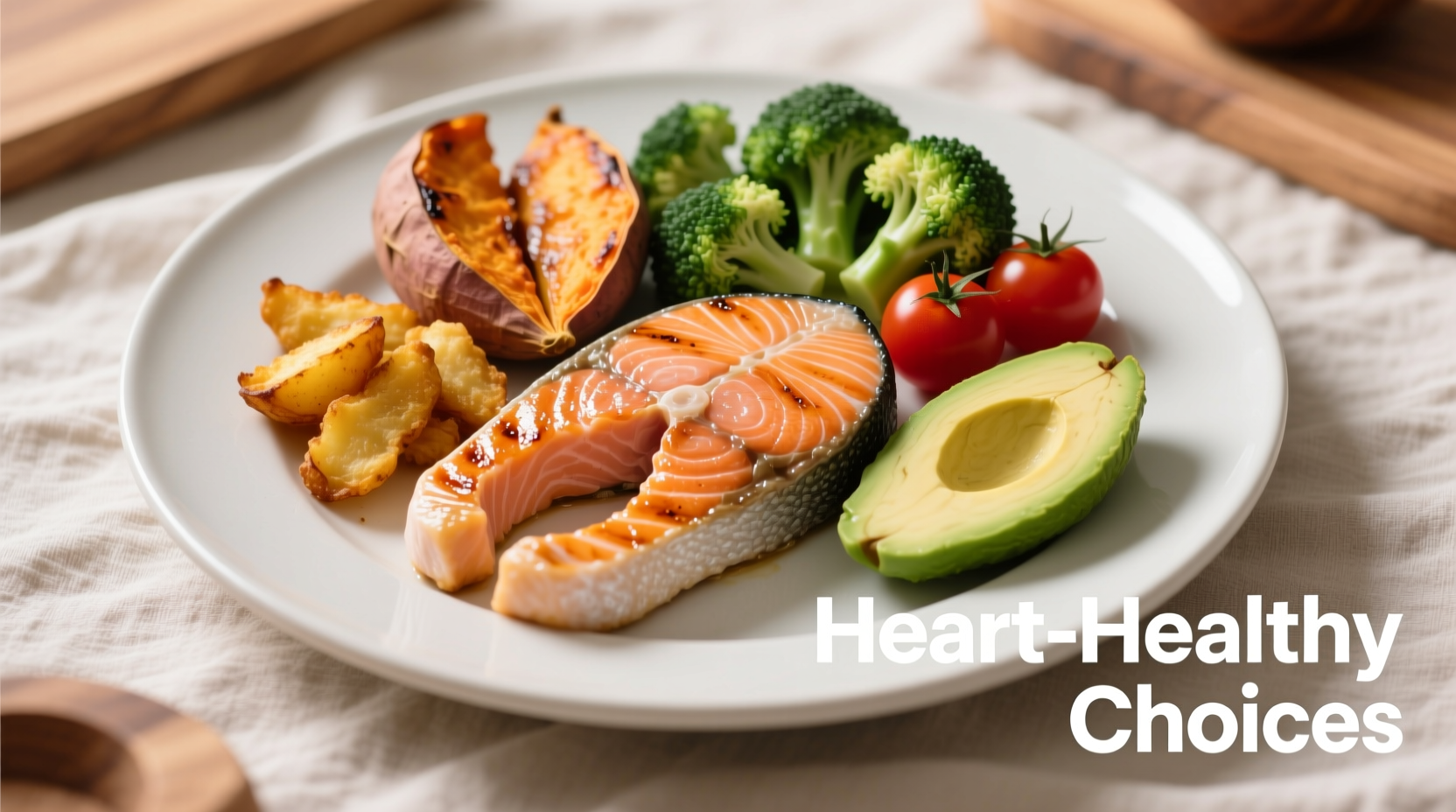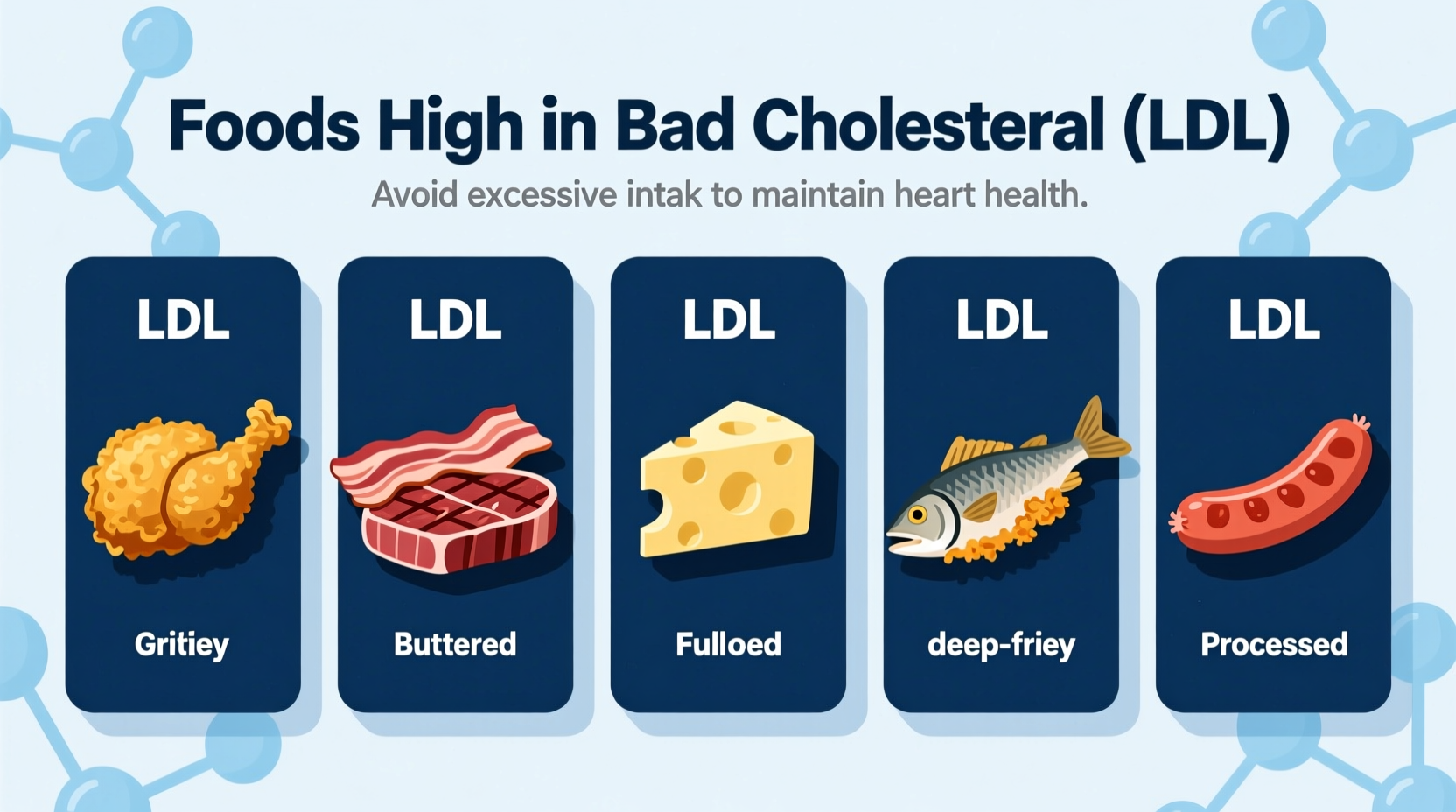Understanding the Cholesterol Confusion: What You Need to Know First
Before we dive into specific foods, let's clarify a critical distinction: "Bad cholesterol" (LDL) isn't something you eat directly. LDL (low-density lipoprotein) is produced by your body. What you do consume are dietary components—primarily saturated fats, trans fats, and to a lesser extent dietary cholesterol—that can raise your LDL levels.
"Foods containing bad cholesterol" is actually a common misconception. No food contains LDL cholesterol itself. Instead, certain foods contain:
- Saturated fats (most impactful for raising LDL)
- Trans fats (extremely impactful for raising LDL)
- Dietary cholesterol (moderate impact for some people)
Why Saturated and Trans Fats Matter More Than Dietary Cholesterol
According to the American Heart Association, saturated fats have a much stronger effect on raising blood LDL cholesterol than dietary cholesterol itself. This explains why recent dietary guidelines have shifted focus from limiting dietary cholesterol to reducing saturated and trans fats.
Here's how different dietary components affect LDL cholesterol levels based on clinical evidence:
| Dietary Component | Primary Food Sources | Impact on LDL Cholesterol |
|---|---|---|
| Saturated Fats | Fatty meats, full-fat dairy, coconut/palm oil | High impact - significantly raises LDL |
| Trans Fats | Partially hydrogenated oils, fried foods, processed snacks | Very high impact - dramatically raises LDL |
| Dietary Cholesterol | Egg yolks, organ meats, shellfish | Variable impact - moderate for some, minimal for most |
Foods That Significantly Raise LDL Cholesterol Levels
1. Processed and Fried Foods High in Trans Fats
Though the FDA has largely banned artificial trans fats, some products still contain them. These are the most problematic for LDL levels:
- Commercially fried foods (french fries, fried chicken)
- Many microwave popcorn varieties
- Certain margarines and vegetable shortenings
- Non-dairy creamers
- Store-bought baked goods (pies, cakes, cookies)
Check ingredient lists for "partially hydrogenated oils"—even if the label claims "0g trans fat," products can contain up to 0.5g per serving if they list this ingredient.
2. Fatty Meats and Meat Products
These foods are high in saturated fats that directly contribute to higher LDL:
- Fatty cuts of beef (ribeye, T-bone)
- Pork belly and bacon
- Lamb and mutton
- Processed meats (sausages, hot dogs, salami)
- Chicken skin and dark meat with skin
The National Heart, Lung, and Blood Institute recommends choosing lean cuts of meat and removing visible fat to reduce saturated fat intake.
3. Full-Fat Dairy Products
While dairy provides important nutrients, full-fat versions significantly increase saturated fat intake:
- Whole milk and half-and-half
- Butter and lard
- Full-fat cheese (cheddar, Swiss, cream cheese)
- Heavy cream and sour cream
- Ice cream
Research published in the American Journal of Clinical Nutrition shows that replacing saturated fats from dairy with unsaturated fats can lower LDL by 5-10%.
4. Tropical Oils and Processed Snacks
These often-overlooked sources pack a saturated fat punch:
- Cookies, crackers, and snack bars
- Candy bars and chocolate
- Pastries and doughnuts
- Foods made with coconut oil or palm oil
- Pre-made pizza crusts and frozen meals

Understanding Individual Responses to Dietary Cholesterol
Not everyone responds to dietary cholesterol the same way. According to research from the National Institutes of Health, approximately 70% of people are "hypo-responders"—their blood cholesterol levels change little with dietary cholesterol intake. The remaining 30% ("hyper-responders") experience more significant increases.
This explains why:
- Egg yolks (containing about 186mg cholesterol each) affect people differently
- Shellfish like shrimp (high in dietary cholesterol but low in saturated fat) may not significantly impact LDL for most
- Organ meats like liver (extremely high in dietary cholesterol) should be limited for hyper-responders
Practical Swaps to Lower Your LDL Naturally
You don't need to eliminate all these foods—strategic substitutions make a significant difference:
Instead of These High-LDL Foods
- Fried chicken → Baked chicken (skin removed)
- Butter → Olive oil or avocado oil
- Whole milk → 1% or skim milk
- Regular ground beef → Lean ground turkey
- Cream cheese → Greek yogurt with herbs
Heart-Healthy Fats to Embrace
- Avocados and avocado oil
- Nuts (almonds, walnuts, pistachios)
- Seeds (chia, flax, pumpkin)
- Fatty fish (salmon, mackerel, sardines)
- Olive oil and canola oil
The Mediterranean diet pattern—which emphasizes these healthy fats—has been shown in multiple studies to reduce LDL cholesterol by 5-10% while improving overall heart health.
Reading Labels Like a Pro: What to Watch For
When evaluating packaged foods, focus on these elements in order of importance:
- Trans fat content (aim for 0g, but check for "partially hydrogenated oils")
- Saturated fat (aim for less than 5% DV per serving)
- Total fat (focus on the type of fat, not just total amount)
- Dietary cholesterol (less critical than saturated/trans fats for most)
Remember that "low cholesterol" claims can be misleading if the product is still high in saturated fats.
When to Consult a Professional
If you have high cholesterol, heart disease, or diabetes, work with a registered dietitian or healthcare provider to develop a personalized eating plan. They can help you understand how your individual genetics and health status affect your response to different dietary components.
Frequently Asked Questions
Do eggs raise bad cholesterol levels?
For most people (about 70%), moderate egg consumption (1-2 eggs daily) has minimal impact on LDL cholesterol. Eggs are high in dietary cholesterol but low in saturated fat. However, about 30% of people (“hyper-responders”) may experience increases in LDL from egg yolks. If you're concerned, consult your healthcare provider about your individual response.
Are all saturated fats equally bad for cholesterol?
No, research suggests that not all saturated fats affect cholesterol equally. For example, stearic acid (found in dark chocolate and some meats) has less impact on LDL than palmitic acid (found in palm oil and animal fats). However, current guidelines still recommend limiting all saturated fats to less than 6% of daily calories for heart health.
How quickly can dietary changes lower LDL cholesterol?
Significant LDL reductions can occur within 4-6 weeks of consistent dietary changes. Replacing saturated fats with unsaturated fats typically lowers LDL by 5-10%. Adding soluble fiber (oats, beans, fruits) can provide additional 3-5% reductions. Maximum benefits are usually seen after 3 months of sustained dietary changes.
Do plant-based meats affect cholesterol?
Many plant-based meats are formulated to be lower in saturated fat than animal meats, which can help lower LDL. However, some contain coconut oil or palm oil (high in saturated fat), so check nutrition labels. Overall, replacing animal meats with plant-based alternatives typically reduces saturated fat intake and may lower LDL cholesterol when part of a balanced diet.











 浙公网安备
33010002000092号
浙公网安备
33010002000092号 浙B2-20120091-4
浙B2-20120091-4